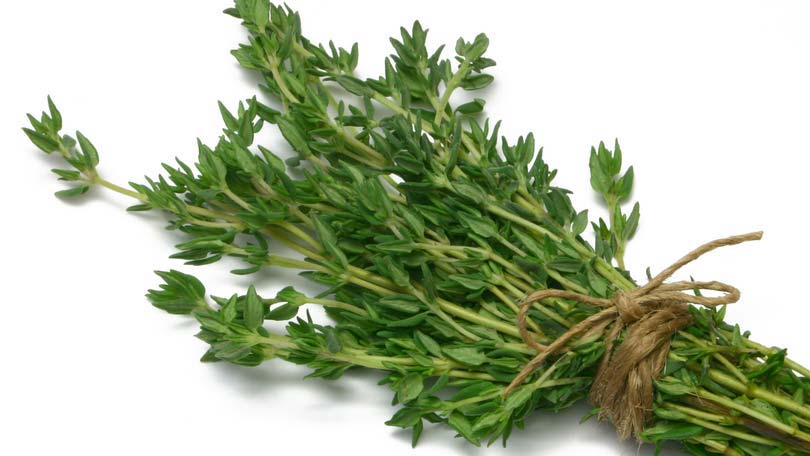
Thyme (Thymus vulgaris), a member of the expansive mint family, is a widely cultivated herb associated with Mediterranean and European cuisine. It is indigenous to the Mediterranean but is also found in Southern Europe and parts of Asia.
Characteristics
Traditional garden thyme is a small perennial herb roughly six to twelve inches in height with slim stems and pairs of narrow, green, olive, or grey-green leaves. The leaves, which are generally ¼ inch long, can have a rust coloring on the underside. The plant also usually buds tiny, pinkish white flowers which have a sweet pollen attractive to insects. The herb itself is pungent and warm, with a hint of spice and a refreshing aftertaste distinctive of many herbs in the mint family.
Thyme’s widespread cultivation has resulted a number of species with culinary significance, the most notable being French (or French Summer) and English (English Winter); other species include T. serpyullum (wild thyme), T. broussonetii (a pine scented version), T. herba-barona (caraway thyme), and T. mastichina (mastic thyme or Spanish marjoram). The herb’s flavor profile can vary depending on the species, ranging from notes of citrus and lemon to hints of mint or nutmeg. While the long list may be confusing, most thyme species on the market can be substituted for each other by the home cook without significant detriment to the food – thyme seems to be delicious no matter where it’s from.
Common Uses
Thyme has a rich history as a mystical, medicinal, and culinary herb, and its use can be traced as far back as the Ancient Greeks. The name thyme actually comes from the Greek “thymon”, meaning “to fumigate” (the purpose that thyme originally served before making its way into the kitchen). It seems to be the Romans who first truly valued the herb for its flavor (they used it in everything from meat entrees to alcohol), and they can take partial credit for the spread of thyme as a kitchen herb as they later introduced the leaves to English cooks.
Closely associated (but not at all limited to) French, European, and Mediterranean food, thyme is a versatile herb. It is a staple ingredient of the classic bouquet garni used to flavor soups and stocks, and is one of the coveted Herbes de Provence (thyme, marjoram, fennel, basil, rosemary, and lavender) in French cuisine. Thyme can be used with most meats, vegetables, soups, stews, and braises, and can add a delicate flavor and aroma to infused oils, herb omelets/eggs dishes, and breads; it pairs particularly well with lemon, garlic, basil, and rosemary. Hymettus honey, renowned as some of the finest is the world, is also said to have a distinctive flavor contributed to by the thyme pollen gathered by local bees.
Aside from its early role as bug repellent, thyme has proved infinitely useful as a medicinal herb. Rich in flavanoids, saponins and other antioxidant compounds, the herb is good for colds, flu, and boosting the immune system (it was thought to ward off the plague during times of epidemic). Thyme was used for hundreds of years to treat “neurological disorders” such as shyness, nightmares, melancholy, anxiety, and depression, and has mild stimulant effects when taken in large doses. The herb’s antiseptic properties also made it a potent staple on battlefields throughout history – its more powerful essential oil, thymol, was rubbed onto wounds to prevent infection, and the oil has also been used in mouthwash and skin creams. The herb has additionally been used in an aromatheraputic manner, stuffed into pillows to treat depression, headaches, epilepsy, and other ailments.
Use and Storage
Thyme can be bought dried or fresh in most supermarkets and at produce vendors. Fresh thyme will keep roughly a week in the fridge; the leaves, separated from their tough stem, can also be frozen in foil for several months.
Dried thyme has a long shelf life (up to two years) when stored in an airtight container away from direct light/heat.
Use It (How to/where)
- in a bouquet garni for soups and stocks
- as part of the Herbes de Provence for French and/or savory dishes
- in herb infused oils for cooking, bread dipping, and dressings
- chopped and added to fluffy herb omelets or quiche
- to garnish salads
- in clam chowder and stews
- paired with meats like lamb, veal, beef, and duck
- to season chicken and other poultry
- in herb butters
- in flavored vinegar
- with almost all vegetables
- in rice pilafs or lentil dishes
Recipe using Thyme
Herbes de Provence
This Provincial spice mix is an excellent dry rub for chicken, lamb, and other meats; it can also be used to flavor roasted or sautéed vegetables, sprinkled on bread before baking, or infused into extra virgin olive oil for dipping. A dry mix is in these cases is best.
1 tablespoon thyme
1 tablespoon marjoram
1 tablespoon savory
1 teaspoon rosemary
½ teaspoon lavender
½ teaspoon basil
Generous pinch fennel seeds
Place herbs in a jar or airtight container with a tight fitting lid. Shake jar to mix. Store out of direct sunlight. Herb mix is best used within 6 months.
Traditional Bouquet Garni
1-2 sprigs fresh thyme
1-2 sprigs fresh parsley
1-2 dry bay leaves
Bundle herbs together and tie tightly with kitchen twine. If herbs do not bundle easily, place in cheesecloth and tie with twine to create a small satchel. Place bouquet garni in soups, stews, stocks, and sauces while cooking. Strain out bouquet before serving.
